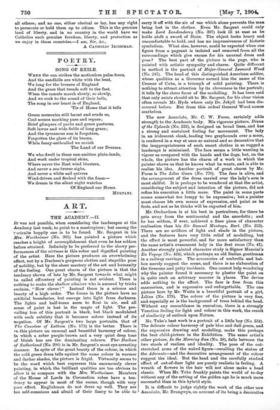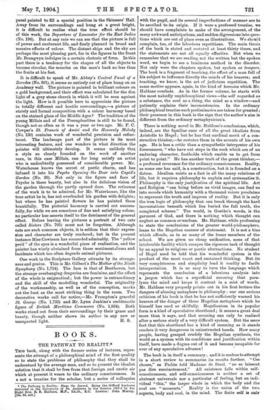IT was not possible, when considering the landscapes at the
Academy last week, to point to a masterpiece ; but among the ortraits happily one is to be found. Mr. Sargent in his Mrs. Wertheimer (No. 301) has painted a picture which reaches a height of accomplishment that even he has seldom before attained. Infinitely to be preferred to the showy per- formances of the virtuoso is this sober and dignified painting of the artist. Here the picture produces an overwhelming effect, not by a Duchess's gorgeous clothes and stagelike pose of nobility, but by the sheer mastery of the art and humanity of the feeling. One great charm of the picture is that the tendency shown of late by Mr. Sargent towards what might be called effrontery of painting is not evident. There is nothing to make the shallow admirer who is amused by tricks exclaim, "How clever!" Instead there is a science and beauty of a high order. The forms in the picture have no artificial boundaries, but emerge into light from darkness. The lights and half-tones seem to float in air, and all sense of paint is lost in the magic of light. The pre- vailing hue of this portrait is black, but black modulated with such subtlety that it becomes colour instead of its negation. Of Mr. Sargent's two large portraits, that of The Countess of Lathom (No. 175) is the better. There is Ln this picture an unusual and beautiful harmony of colour, in which a sober purple-brown and a very quiet deep tone of bluish hue are the dominating colours. The Duchess of Sutherland (No. 206) is in Mr. Sargent's most eye-arresting manner. In spite of the great beauty of the colour, in which the cold green dress tells against the same colour in warmer and darker shades, the picture is frigid. Virtuosity seems to be the word which best expresses this enormously clever painting, in which the brilliant qualities are too obvious to allow it to compare with the Mrs. Wertheimer. Members of the House of Lords in Coronation robes have a ten- dency to appear in most of the rooms, though with very poor effect. Englishmen do not dress up well. They are too self-conscious and afraid of their finery to be able to
carry it off with the air of nse which alone prevents the man being lost in the clothes. Even Mr. Sargent could only make Lord Londonderry (No. 397) look ill at ease as he holds aloft a sword of State. The object looks heavy and uncomfortable to hold, and has no impressiveness of historic symbolism. What else, however, could be expected when one figure from a pageant is isolated and removed from all the surroundings which give excuse for his unusual dress and pose ? The best part of the picture is the page, who is painted with artistic sympathy and charm. Quite different in method is the portrait of Major-General Leonard Wood (No. 247). The head of this distinguished American soldier, whose qualities as a Governor earned him the name of the Cromer of Cuba, is a triumph of solid painting. There is nothing to attract attention by its cleverness in the portrait; it tells by the sheer force of the modelling. It has been said that only saints should sit to Mr. Sargent, for his clear vision often reveals Mr. Hyde where only Dr. Jekyll had been dis- covered before. But from this ordeal General Wood comes scatheless.
The new Associate, Mr. C. W. Furse, certainly adds strength to the Academic body. His vigorous picture, Diana of the Uplands (No. 222), is designed on broad lines, and has a strong and sustained feeling for movement. The lady in an iridescent cloak, leading two greyhounds over a moor, is rendered in a way at once so natural and so decorative that the inappropriateness of such smart clothes in so rugged a landscape is minimised. The face seems a little wanting in vigour as compared with the hands and the dogs, but, on the whole, the picture has the charm of a work in which the painter shows us that he knows what he wants, and is able to realise his idea. Another portrait of great charm by Mr. Furse is The Lilac Gown (No. 770). The face is alive, and the arrangement of the dress carried over the lady's arm is most skilful. It is perhaps to be wondered at that the artist, considering the subject and intention of the picture, did not refine his execution a little more. The paint in some parts seems somewhat too lumpy to be expressive ; but a painter must choose his own means of expression, and paint as he feels, and not as he thinks will be expected of him.
Mr. Orchardson is at his best in portraiture, for there he gets away from the sentimental and the anecdotic ; and he has seldom, if ever, achieved a finer piece of character realisation than his Sir Samuel Montagu, Bart. (No. 253). There are no artifices of light and shade in the picture, and the features have very little relief of modelling, but the effect is most powerful, and far more satisfactory than the same artist's evanescent lady in the first room (No. 41). Another strongly painted character study is Signor Mancini's En Voyage (No. 424), which portrays an old Italian gentleman in a railway carriage. The accessories of umbrella and hat- box merely suggest the scene, and there is no elaboration of the tiresome and petty incidents. One cannot help wondering why the painter found it necessary to plaster the paint on in quite such an arbitrary manner in places. The device adds nothing to the effect. The face is free from this mannerism, and is expressive and unforgettable. The one picture here by Mr. Watts is a beautiful portrait of a girl, Lilian (No. 179). The colour of the picture is very fine, and especially so is the background of trees behind the head. Without any resemblance in execution, there is a strongly Venetian feeling for light and colour in this work, the result of similarity of outlook upon Nature.
Mr. Tuke's best work is a portrait of a little boy (No. 554). The delicate colour harmony of pale blue and dull green, and the expressive drawing and modelling, make this perhaps the best child-picture in the Exhibition. The same artist's other picture, In the Morning Sun (No. 38), falls between the two stools of realism and ideality. The pose of the out- stretched arms of the naked figure—recalling the statue of the Adorantc—and the decorative arrangement of the colour suggest the ideal. But the head and the carefully studied effect of out-of-door light are purely realistic in feeling. A wreath of flowers in the hair will not alone make a bead classic. When Mr. Tuke frankly paints the world of to-day without any of the setting of the golden age he is much more successful than in this hybrid style.
It is difficult to judge rightly the work of the other new Associate, Mr. Brangwyn, on account of its being a decorative
panel painted to fill a special position in the Skinners' Hall. Away from its surroundings and hung at a great height, it is difficult to realise what the true effect should be of this work, the Departure of Lancaster for the East Indies (No. 196). But at any rate we can see that the picture is full of power and exuberant life, and finely planned in broad and massive effects of colour. The distant ships and the sky are perhaps the most pleasing part, for in the figures in the front Mr. Brangwyn indulges in a certain rhetoric of form. In this part there is a tendency for the shapes of all the objects to become circular, the muscles on the man's back no less than the fruits at his feet.
It is difficult to speak of Mr. Abbey's Central Panel of a Reredos (No. 361), it seems so entirely out of place hung on an Academy wall. The picture is painted in brilliant colours on a gold background, and their effect was calculated for the dim light of a grey stone church in which it will be seen against the light. How is it possible here to appreciate the picture in totally different and hostile surroundings,—a. picture of stately and formal composition with a colour harmony based on the stained glass of the Middle Ages ? The tradition of the young Millais and of the Preraphaelites is still to be found, though not so often as it was a year or two ago. Mr. F. C. Cowper's St. Francis of Assisi and the Heavenly Melody (No. 130) contains work of wonderful precision and refine- ment. The landscape part of the picture is its most interesting feature, and one wonders in what direction the painter will ultimately develop. It seems unlikely that a style so closely founded on the work of another man, in this case Millais, can for long satisfy an artist who is undoubtedly possessed of considerable power. Mr. Waterhouse knows the secret of poetic charm, and has infused it into his Psyche Opening the Door into Cupid's Garden (No. 30). Not only in the figure and face of Psyche is there beauty, but also in the delicious vision of the garden through the partly opened door. The reticence of the work is to be admired, for Mr. Waterhouse, like the true artist he is, has not overloaded his garden with delights ; but where he has painted flowers he has painted them beautifully. The pictorial harmony is carried out success- fully, for while we are conscious of fine and satisfying colour, no particular hue asserts itself to the detriment of the general effect. Before leaving the pictures a portrait of two cats called Sisters (No. 705) must not be forgotten. Although cats are such common objects, it is seldom that their expres- sion and character are truly rendered; but in the present instance Miss Cowieson has succeeded admirably. The " yellow peril" of the eyes is a wonderful piece of realisation, and the painter has wisely abstained from those sentimentalisms and incidents which too often degrade animal pictures.
One work in the Sculpture Gallery attracts by its strange- ness and genius. This is Mr. Gilbert's The Mother of the Ninth Symphony (No. 1,714). The face is that of Beethoven, but the strange overhanging draperies are feminine, and the effect of the whole is enigmatical ; but the power is extraordinary and the skill of the modelling wonderful. The originality of the workmanship, as well as of the conception, marks out the bust as the most striking thing in the room. Two decorative works call for notice,—Mr. Frampton's graceful , St. George (No. 1,733) and Mr. Lynn Jenkins's emblematic figure of British Maritime Commerce (No. 1,834). Both works stand out from their surroundings by their 'grace and beauty, though neither shows its author in any new or
unexpected light. H. S.











































 Previous page
Previous page